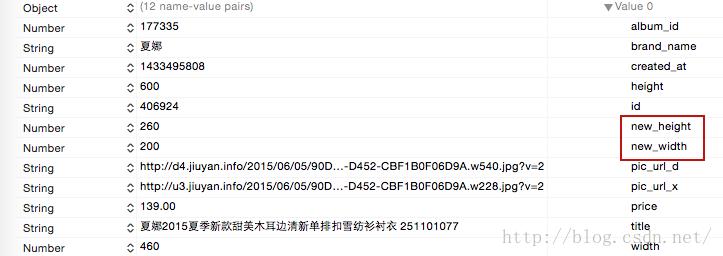iOSUITableView实现的瀑布流效果
Posted 小猿猪哥
tags:
篇首语:本文由小常识网(cha138.com)小编为大家整理,主要介绍了iOSUITableView实现的瀑布流效果相关的知识,希望对你有一定的参考价值。
这段时间看了一些关于瀑布流的文章。有些是使用UICollectionView实现的有些是使用UItableView实现的。两种方法都试验过,最后还是觉得使用UItableView实现的效果要好一些。
工程源码:点击打开链接 https://github.com/zhuming3834/UITableView-waterfall
下面的这两张图的对比就是说明。 左边是使用UItableView实现的效果图,右边是使用UICollectionView实现的效果图。


最主要的区别是图片之间的上下间距。
每张图片所在的数据模型中数据单元有:

数据已经说明了图片的尺寸信息,这里我们只需要根据需求做缩放即可,不需要再去获取图片的size信息了。
在使用三个tableView实现之前,当时就觉得三个tableView怎么样让它们一起滚动呢?
后来看了UItableView的的协议方法后,找了这么一个方法:
- (void)scrollViewDidScroll:(UIScrollView *)scrollView;主要使用了两个第三方库:AFNetworking和SDWebImage。
这里我是封装了一个下载类,声明了一个协议
下载类的方法:数据下载完成欧通过协议放回个另一方。由于有三个下载的链接,我就给每一个下载加了一个identity用于区分。
AFNetworkModel.m
/**
* AFNetwork类下载数据
*
* @param URLString 下载地址的URLString
*/
- (void)downloadDataFromURLString:(NSString *)URLString
NSURL * url = [NSURL URLWithString:URLString];
#pragma mark - 监听网络状态
AFHTTPRequestOperationManager * manage = [[AFHTTPRequestOperationManager alloc] initWithBaseURL:url];
[manage.reachabilityManager setReachabilityStatusChangeBlock:^(AFNetworkReachabilityStatus status)
if (status == AFNetworkReachabilityStatusUnknown || status == AFNetworkReachabilityStatusNotReachable)
UIAlertView * netStatusAl = [[UIAlertView alloc] initWithTitle:@"服务器连接失败" message:@"请检查网络连接" delegate:nil cancelButtonTitle:nil otherButtonTitles:@"确定", nil];
[netStatusAl show]; //请检查网络连接
];
//开始监听
[manage.reachabilityManager startMonitoring];
#pragma mark - AFHTTP异步下载后 解析Json数据 代理
manage.responseSerializer = [AFHTTPResponseSerializer serializer];
[manage GET:URLString parameters:nil success:^(AFHTTPRequestOperation *operation, id responseObject)
// NSLog(@"responseObject = %@",responseObject);
[self.delegate getDownloadData:responseObject withAFNetworking:self];
failure:^(AFHTTPRequestOperation *operation, NSError *error)
// NSLog(@"error = %@",error);
//1.服务器连接失败
//2.断网
UIAlertView * netStatusAl = [[UIAlertView alloc] initWithTitle:@"服务器连接失败" message:@"请检查网络连接" delegate:nil cancelButtonTitle:nil otherButtonTitles:@"确定", nil];
[netStatusAl show]; //请检查网络连接
];
AFNetworkModel.h
/**
* 声明一个协议
*/
@protocol AFNetworkDownloadDelegat <NSObject>
- (void)getDownloadData:(NSData *)downloadData withAFNetworking:(id)AFNetwork;
@end
@interface AFNetworkModel : NSObject
@property (nonatomic,copy)NSString * identity;
@property (nonatomic,strong)id<AFNetworkDownloadDelegat>delegate;
- (void)downloadDataFromURLString:(NSString *)URLString;
@end
还是看看主要的实现部分。
//
// ViewController.m
// UITableView-waterfall
//
// Created by HGDQ on 15/10/7.
// Copyright (c) 2015年 HGDQ. All rights reserved.
//
#import "ViewController.h"
#import "BaseModel.h"
#import "AFNetworkModel.h"
#import "MyTableViewCell.h"
#import "UIImageView+WebCache.h"
#define URLSTRING1 @"http://itugo.com/client/ios/api/getpiclist?_version=20140117.2.5.1&_req_from=oc&_source=ios&type=&_uuid=efe47094e00109db8c28cf0ae9b607b9&max=&tag=&_promotion_channel=App%20Store&_platform=iPhone&sort=new&from=tag&_uiid=2FF998CF0D2A40E7AF6F8FAFB8F57538&_net=wifi&min=0"
#define URLSTRING2 @"http://itugo.com/client/ios/api/getpiclist?_version=20140117.2.5.1&_req_from=oc&_source=ios&type=accessary&_uuid=efe47094e00109db8c28cf0ae9b607b9&max=&tag=&_promotion_channel=App%20Store&_platform=iPhone&sort=new&from=tag&_uiid=2FF998CF0D2A40E7AF6F8FAFB8F57538&_net=wifi&min=0"
#define URLSTRING3 @"http://itugo.com/client/ios/api/getpiclist?_version=20140117.2.5.1&_req_from=oc&_source=ios&type=shoes&_uuid=efe47094e00109db8c28cf0ae9b607b9&max=&tag=&_promotion_channel=App%20Store&_platform=iPhone&sort=new&from=tag&_uiid=2FF998CF0D2A40E7AF6F8FAFB8F57538&_net=wifi&min=0"
@interface ViewController ()<UITableViewDataSource,UITableViewDelegate,AFNetworkDownloadDelegat>
@property (nonatomic,strong)NSArray *URLArray;
@property (nonatomic,strong)NSArray *tableViewArr1;
@property (nonatomic,strong)NSArray *tableViewArr2;
@property (nonatomic,strong)NSArray *tableViewArr3;
@end
@implementation ViewController
- (void)viewDidLoad
[super viewDidLoad];
self.view.backgroundColor = [UIColor grayColor];
[self getURLArray];
[self startDownload];
[self setMainView];
// Do any additional setup after loading the view, typically from a nib.
/**
* 新建主界面的三个tableView
*/
- (void)setMainView
for (int i = 0; i < self.URLArray.count; i ++)
UITableView *tableView = [[UITableView alloc] init];
tableView.frame = CGRectMake(5*(i + 1) + 100*i, 0, 100, 568);
tableView.tag = 100 + i;
tableView.delegate = self;
tableView.dataSource = self;
[self.view addSubview:tableView];
tableView.bounces = NO;
tableView.showsVerticalScrollIndicator = NO;
[tableView registerNib:[UINib nibWithNibName:@"MyTableViewCell" bundle:nil] forCellReuseIdentifier:@"Cell"];
/**
* 设置每个tableView里面显示的cell的个数
*
* @param tableView tableView本身
* @param section 第几个section
*
* @return 需要设置的个数
*/
- (NSInteger)tableView:(UITableView *)tableView numberOfRowsInSection:(NSInteger)section
NSInteger tag = tableView.tag;
if (tag == 100)
return self.tableViewArr1.count;
if (tag == 101)
return self.tableViewArr2.count;
if (tag == 102)
return self.tableViewArr3.count;
return 0;
/**
* 设置cell的高度
*
* @param tableView tableView本身
* @param indexPath cell的位置
*
* @return 设置的高度
*/
- (CGFloat)tableView:(UITableView *)tableView heightForRowAtIndexPath:(NSIndexPath *)indexPath
NSInteger tag = tableView.tag;
if (tag == 100)
BaseModel *model = (BaseModel *)self.tableViewArr1[indexPath.row];
float height = model.height.floatValue;
return height/2.0;
if (tag == 101)
BaseModel *model = (BaseModel *)self.tableViewArr2[indexPath.row];
float height = model.height.floatValue;
return height/2.0;
if (tag == 102)
BaseModel *model = (BaseModel *)self.tableViewArr3[indexPath.row];
float height = model.height.floatValue;
return height/2.0;
return 0;
/**
* tableView加载cell
*
* @param tableView tableView 本身
* @param indexPath cell的位置
*
* @return cell
*/
- (UITableViewCell *)tableView:(UITableView *)tableView cellForRowAtIndexPath:(NSIndexPath *)indexPath
NSInteger tag = tableView.tag;
static NSString * identify = @"Cell";
MyTableViewCell * cell = [tableView dequeueReusableCellWithIdentifier:identify];
if (cell == nil)
cell = [[[NSBundle mainBundle] loadNibNamed:@"MyTableViewCell" owner:self options:nil] firstObject];
if (tag == 100)
BaseModel *model = (BaseModel *)self.tableViewArr1[indexPath.row];
[cell.backImageView setImageWithURL:[NSURL URLWithString:model.pic_url_d]];
return cell;
if (tag == 101)
BaseModel *model = (BaseModel *)self.tableViewArr2[indexPath.row];
[cell.backImageView setImageWithURL:[NSURL URLWithString:model.pic_url_d]];
return cell;
if (tag == 102)
BaseModel *model = (BaseModel *)self.tableViewArr3[indexPath.row];
[cell.backImageView setImageWithURL:[NSURL URLWithString:model.pic_url_d]];
return cell;
return nil;
/**
* tableView滚动的协议方法
*
* @param scrollView scrollView
*/
- (void)scrollViewDidScroll:(UIScrollView *)scrollView
UITableView *tableView1 = (UITableView *)[self.view viewWithTag:100];
UITableView *tableView2 = (UITableView *)[self.view viewWithTag:101];
UITableView *tableView3 = (UITableView *)[self.view viewWithTag:102];
if (scrollView == tableView1)
[tableView2 setContentOffset:tableView1.contentOffset];
[tableView3 setContentOffset:tableView1.contentOffset];
if (scrollView == tableView2)
[tableView1 setContentOffset:tableView2.contentOffset];
[tableView3 setContentOffset:tableView2.contentOffset];
if (scrollView == tableView3)
[tableView2 setContentOffset:tableView3.contentOffset];
[tableView1 setContentOffset:tableView3.contentOffset];
/**
* 把下载链接存进数组
*/
- (void)getURLArray
self.URLArray = @[URLSTRING1,URLSTRING2,URLSTRING3];
/**
* 开始下载数据
*/
- (void)startDownload
for (int i = 0; i < self.URLArray.count; i ++)
AFNetworkModel *model = [[AFNetworkModel alloc] init];
model.identity = [NSString stringWithFormat:@"%d",i];
model.delegate = self;
[model downloadDataFromURLString:self.URLArray[i]];
/**
* 下载数据协议方法
*
* @param downloadData 下载成功后返回的数据
* @param AFNetwork AFNetworkModel本质
*/
- (void)getDownloadData:(NSData *)downloadData withAFNetworking:(id)AFNetwork
AFNetworkModel *model = (AFNetworkModel *)AFNetwork;
//得到AFNetworkModel的identity
NSString *identify = model.identity;
//解析下载后的数据
NSDictionary *dice = [NSJSONSerialization JSONObjectWithData:downloadData options:NSJSONReadingMutableContainers error:nil];
if ([identify isEqualToString:@"0"])
UITableView *tableView = (UITableView *)[self.view viewWithTag:100];
BaseModel *dataModel = [[BaseModel alloc] init];
self.tableViewArr1 = [dataModel setBaseModelWithDictionary:dice];
[tableView reloadData];
if ([identify isEqualToString:@"1"])
UITableView *tableView = (UITableView *)[self.view viewWithTag:101];
BaseModel *dataModel = [[BaseModel alloc] init];
self.tableViewArr2 = [dataModel setBaseModelWithDictionary:dice];
[tableView reloadData];
if ([identify isEqualToString:@"2"])
UITableView *tableView = (UITableView *)[self.view viewWithTag:102];
BaseModel *dataModel = [[BaseModel alloc] init];
self.tableViewArr3 = [dataModel setBaseModelWithDictionary:dice];
[tableView reloadData];
- (void)didReceiveMemoryWarning
[super didReceiveMemoryWarning];
// Dispose of any resources that can be recreated.
@end
数据模型的封装部分可以由于上面JSON数据截图里面的有些字段有new_XX的以new开头的,在Xcode6.4里面是不合法的,所以我就重新取了名字,单个使用KVC。
BaseModel.h
#import <Foundation/Foundation.h>
@interface BaseModel : NSObject
@property (nonatomic,copy)NSString *brand_name;
@property (nonatomic,copy)NSNumber *height;
@property (nonatomic,copy)NSNumber *width;
@property (nonatomic,copy)NSString *pic_url_d;
@property (nonatomic,copy)NSString *pic_url_x;
@property (nonatomic,copy)NSString *price;
@property (nonatomic,copy)NSString *title;
- (NSArray *)setBaseModelWithDictionary:(NSDictionary *)dice;
@endBaseModel.m
#import "BaseModel.h"
@implementation BaseModel
/**
* 把封装的数据模型存入数组
*
* @param dice 需要分装的字典
*
* @return 模型数组
*/
- (NSArray *)setBaseModelWithDictionary:(NSDictionary *)dice
NSMutableArray *baseModelArr = [[NSMutableArray alloc] init];
NSArray *dataArr = dice[@"data"][@"data"];
for (NSDictionary *dic in dataArr)
BaseModel *model = [BaseModel setModelWithDictionary:dic];
[baseModelArr addObject:model];
return baseModelArr;
/**
* 数据模型的封装
*
* @param dice 需要封装的字典数据
*
* @return 返回一个封装好的数据模型
*/
+ (BaseModel *)setModelWithDictionary:(NSDictionary *)dice
BaseModel *model = [[BaseModel alloc] init];
//由于数据存在以new开头的字段,这里重新声明了属性 选取关键数据单个封装
[model setValue:dice[@"brand_name"] forKey:@"brand_name"];
[model setValue:dice[@"new_height"] forKey:@"height"];
[model setValue:dice[@"new_width"] forKey:@"width"];
[model setValue:dice[@"pic_url_d"] forKey:@"pic_url_d"];
[model setValue:dice[@"pic_url_x"] forKey:@"pic_url_x"];
[model setValue:dice[@"price"] forKey:@"price"];
[model setValue:dice[@"title"] forKey:@"title"];
return model;
@end做完后觉得瀑布流不难,但是还有许多需要关注的细节部分可能是比较难的,只是我没发现。还需要仔细研究瀑布流。
以上是关于iOSUITableView实现的瀑布流效果的主要内容,如果未能解决你的问题,请参考以下文章